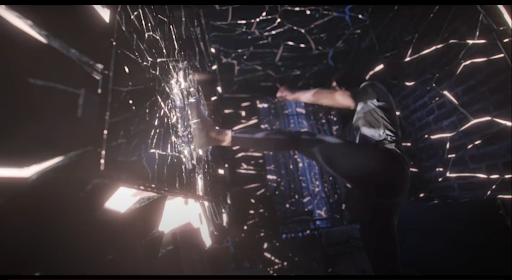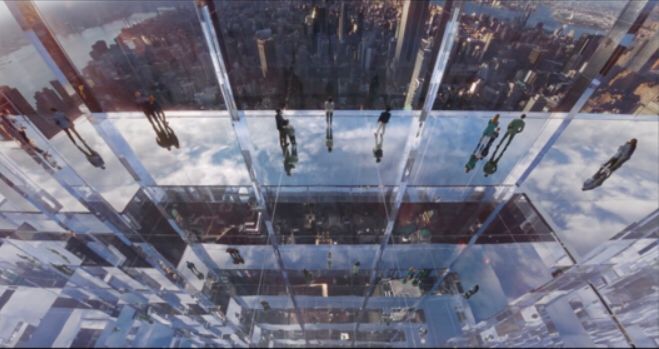Public-Private Partnerships for Mediate-Immediate Experiences
Posted by <Nate Sloan> on 2021-09-15
A new video advertisement for the observation deck of One Vanderbilt Avenue, a recently completed skyscraper in midtown Manhattan, plays on the anxieties of an increasingly precariatized NYC PMC. The exposed brick walls of a “typical” New York apartment are seen to close in on our zoom-meeting-bound subject. Endless hours spent in front of a screen within a single small enclosed space, at once both home and office, is the new reality for many. The “experience” provided by a visit to this observation deck, branded Summit OV, is positioned as the antidote to this novel form of claustrophobia.
In frustration, our subject hurls her laptop at the television, which spews fear-mongering cable news into her environment. A bright crack appears, letting in light from an unknown space beyond the confines of the apartment. She then violently attempts to enlarge this crack in order to break down the smothering boundaries of the space she occupies.

Our subject breaking down the boundaries of her enclosure
The cracks grow larger, and before long the dark brick enclosure is blown apart, replaced by a near-infinite realm of mirrored glass fragments. The shards slowly begin to fuse, leaving our subject to “EXPERIENCE A NEW REALITY” (sic) high above the Manhattan streets. The final frame of the ad identifies the product as “a new global cultural experience.” (See footnote 1)

The ethereal realm above Manhattan to which our subject ascends
The subject of this advertisement, through this quasi-apotheosis, is freed from the anxiety of enclosure and given access to an ethereal plane in which their vision is extended, godlike. (See footnote 2)
Ascend the heavens. Claim your celestial birthright. Post about it on instagram.
This phenomenon of the commodified experience of the skyscraper is nothing new. Visits to the top of the Empire State building along with countless others have been on offer for decades. However, the specific marketing apparatus now being deployed to advertise new examples of this phenomenon, and the interaction of these commodified experiences with the incentives of social media are novel in their precise functioning. Statistically, you will never live in one of these buildings, yet you can secure your claim to the grandeur and sublime separation from the world below by posting an image to social media.
On Vessel, the abstract sculpture-cum-building that lies at the center of Hudson Yards, all photos you take are the legal property of the entity that owns the edifice. (See footnote 3) Yet for this small price, you may enter the pure Deleuzean smooth space of its honeycomb staircases. You are a single node traversing the neutral field, a lone actor framed by the network. You enter, as Douglas Spencer terms it, “an architecture of pure circulation.” (See footnote 4)

The ethereal realm above Manhattan to which our subject ascends
New architectural marvels like Vessel and One Vanderbilt Avenue are indicative of the ambitions of architects who have abandoned social critique for the “progressive” forms of Deleuzean architecture. By emphasizing horizontality, hierarchy is diminished, or so goes the logic. Generally, Deleuzism in architecture may be characterized by the employment of concepts theorized by Deleuze (and sometimes Guattari) in the context of architectural practice. (See footnote 5) These concepts, such as the notions of smooth vs. striated space and the rhizome, that were originally intended to identify new modes of deterritorialization in the context of post-fordist, neoliberal capitalism, are instead embraced as desirable ideals to aspire to, rather than diagnoses of new methods of subjection.
Pure horizontality, parametric design, and nodal connectivity characterize much of the architectural output of firms like Zaha Hadid Architects, FOA, and KPF. Having embraced the elimination of hierarchy as a design rather than as a social or political problem, real differences between “actors in a network” are elided.
In the space of these advertised architectural experiences, social relations are supposedly suspended as one enters a commodified dreamscape. These fantasies obfuscate the contradictions that characterize an architectural practice that has embraced the market as an engine of change. In the thought of Bruno Latour, or those who otherwise propound the various derivatives of Heideggerian object-oriented ontology, analysis of class structure is largely suspended in favor of one that distributes agency equally across all human as well as non-human actors.
This postulation of equality is plain to see in the advertisements for these experiences, which are populated with actors of diverse identity groups. However, the price tag attached to these experiences makes sure that they are indeed not for everyone. (See footnote 6) The price of these experiences also exemplifies the extent to which the space of the semi-public/semi-private has replaced the notion of public space in the new ideal urban environment.
A text published by the designers of One Vanderbilt, the architectural firm Kohn Pedersen Fox (KPF), entitled “One Vanderbilt: 100 Years in the Making,” posits a historical lineage that links Grand Central Terminal and One Vanderbilt in their reliance on the public/private partnership. (See footnote 7) “Underscoring Grand Central Terminal’s success”, the document asserts, “is the value of public/private partnerships in development.” It goes on further to make the bold claim that “urban transformation is historically rooted in commercial enterprise.” While this may be true to some extent, it obscures the ways in which public and governmental authority have structured urban transformation. In the case of New York City, specifically Manhattan, the evidence for public intervention in the urban fabric quite literally surrounds you. The Commissioner’s Plan of 1811 that laid out the island’s famed grid plan was carried out by the Common Council of the city, and certainly not by private enterprise. Who knows how tortuous, complex, and unnavigable the city may have become if private entities were left to determine the layout of the streets according to their individual interests.
It is especially absurd for KPF to praise private enterprise in the case of Grand Central, given that, had the free market been left to take its course, it would have been demolished just like old Penn Station. (See footnote 8) Indeed, there were multiple proposals for its demolition after ridership declined in the 1950s. It was public authority that kept the historic terminal standing: its listing on the National Register of Historic Places and its declaration as a National Historic Landmark were vital to its survival.
Far from working together, the public and private sectors are at odds, as their incentives and goals are (or ought to be) completely different. As is clear in 2021, the totality of individuals seeking the maximization of their own self-interest does not result in the achievement of the high-minded, idealistic goals that were once the object of public-centric thinking during the 18th, 19th, and 20th centuries. The extent to which neoliberal policy has fostered these “partnerships” is not a matter of symbiosis, but of the replacement of all aspirations proper to the public with those of neoliberal capital.
There was a time when public space and public works were prized as vital components of city life. Both Central Park and the Brooklyn Bridge were intended as spaces to be inhabited by all. Members of all classes were given access to a space that enhanced city life. While the social reality of the late 19th century stood in stark contrast to the idealistic aims of contemporary urban reformers, the legacy of the Enlightenment remained an object of aspiration. The symbolic gesture of these interventions indicated a conception of the urban environment that valued the notion of public space. Vessel, Summit OV, Edge, Little Island, along with countless others, however, demonstrate the extent to which this notion of public space has been eroded, replaced with the P U B L I C P R I V A T E P A R T N E R S H I P, that ominous alliteration that signals the hollowing out of all sets of relations not subsumed under the market.

These experiences are perhaps the most visible aspects of the assault by neoliberal techno-capital on the conception of public space per se. One needs look no further than Hudson Yards to see the ideal-type of the public/private partnership, the neoliberal urban conglomeration of tourist attraction and shopping mall that is nevertheless viewed as an example to be emulated by developers everywhere. However, this model urban environment is deceptive with regard to the absence within its boundaries of the societal ills that plague all cities organized under the current order. The unhoused, for example, are kept from Hudson Yards by police armed with rifles. This exclusion maintained by implicit violence is imperative in keeping the fiction alive. At a time when additional train service is desperately needed in the outer boroughs, a luxe new station and line extension was recently built here to facilitate circulation through this environment without the need to walk through surrounding neighborhoods. No space can truly be public if it exists by means of the exclusion of a certain subset of that public, i.e. the unhoused. Rather, Hudson Yards and other zones like it exist as a hollow approximation of public space primarily designed to increase tourist revenues to the city. (See footnote 9)
It is imperative to question the extent to which these experiences of summiting the Manhattan skyline play a role in reproducing neoliberal subjectivity. By means of allowing access, albeit temporary, to the sublime experience of the observation deck, the height of these towering edifices, visitors are again reminded of what awaits them if they continue to play the game, if they continue to act as good neoliberal & exploited subjects. These “experiences” are a vital aspect of these buildings, as they allow for the continuance of the myth of meritocracy. By making a small fraction of these glittering towers “public”, they reaffirm the importance of keeping them private, and the importance of their existence in the first place.
The images uploaded to social media by visitors to these experiences are a vital aspect of this reproduction of subjectivity. Not only does the social media post cement the status of the photo’s subject as having claimed for themself a piece of this sublime experience, it also raises the profile of this experience among those who see the post. Playing on the FOMO of social media users, the skyline selfie asserts partial, virtual dominion.
When the Latting Observatory was built in 1853 for the Exhibition of the Industry of All Nations, it allowed Manhattanites for the first time to see with their own eyes the extent and finitude of the island. As architectural theorist Rem Koolhaas notes:
"To have a sense of the island as a whole is also to be aware of its limitations, the irrevocability of its containment. If this new consciousness limits the field of their ambition, it can only increase its intensity. Such inspections from above become a recurrent theme under Manhattanism; the geographical self-consciousness they generate is translated into spurts of collective energy, shared megalomaniac goals.” (See footnote 10)
While the first opportunity to lord above Manhattan’s street, represented by the Latting Observatory, resulted in the “spurts of collective energy” towards urban development described by Koolhaas, the most recent examples I have described above accomplish nothing of the sort. Rather than encouraging visitors to imagine innovative ways to organize an urban environment within the confines of limited space, the contemporary observatory experience serves to entice attendees with the seemingly limitless financial and economic opportunity symbolized by the contemporary Manhattan skyline. This is perhaps best exemplified by a subsection of the Summit OV experience entitled Transcendence. It is a hall of mirrors in the sky, which shows the visitor a reflected infinity of Manhattans, and in so doing temporarily belies the finitude of the island, noted by Koolhaas above. In this way it supports the fantasy of endless growth under the current order. Additionally, the quasi-religious language employed here underscores further the extent to which this experience plays on the now secularized desires for relief from the hectic world of contemporary capitalism.
This false hope is increasingly important at a time when the myth of upward mobility is revealed more and more each day to be as hollow as Vessel. As more and more college-educated, would-be members of the media class are feeling the void open up beneath them, the looming threat of proletarianization, more and more must be done to sustain the fantasy of equal opportunity under the neoliberal order.
--------------------------------------------------
1. Promotional language on Summit OV’s website, in a subsection termed “Our Mission”, asserts that the experience "changes our relationship with cities, environment, and ourselves through immersive, multi-sensory experiences.”
2.This video was published to Youtube on June 17th, 2021. An advertisement for the observation deck of One World Trade, published to Youtube on May 6th, 2021 plays on many of the same insecurities. While it doesn’t make use of a fantastical CG sequence, it encourages potential visitors to “rise above every expectation” and “elevate your experience.”
3. James Tarmy, “After Public Outcry, a Rewritten Photo Policy for Hudson Yards’ ‘Vessel.’” Bloomberg News, March 18, 2019.
4. Douglas Spencer, Critique of Architecture, p. 90
5. For more on the embrace of Deleuze in architecture see: Douglas Spencer, Smooth Operators: Architectural Deleuzism in Societies of Control.
6. $36 general admission, $71 premium admission. Link to their site.
7. “One Vanderbilt: 100 Years in the Making.” KPF.
8. Kevin Baker, “The Near Death of Grand Central Terminal.” Harpers, June 19, 2014.
9. For more on the reprehensible absurdity of Hudson Yards, see Dank Lloyd Wright’s work and accompanying explanatory text in this publication.
10. Rem Koolhaas, Delirious New York, p. 25